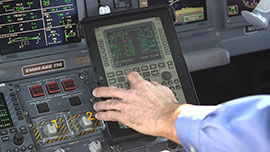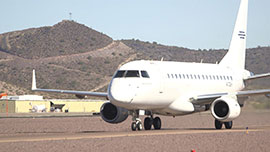- Slug:BIZ-Honeywell, About 500 words
- Photos (thumbnails, captions below)
By MERYL FISHLER
Cronkite News
PHOENIX – The pilot gives one simple command: “Departure.”
That one spoken word triggers the tablet mounted in the middle of the cockpit to initiate the process.
The pilot is using voice-recognition technology that officials with Phoenix-based Honeywell Aerospace call a “huge advancement” in the cockpit.
Without the technology, the pilot would have to type in several commands.
Jim Anderson, a veteran pilot and lecturer in the aviation program at Arizona State University, said that current control systems force him to look down.
“(I have to) lower my head, and it takes away from looking outside,” he said. “Voice recognition is the next step. You can just say it.”
Honeywell’s aerospace division, which focuses on inventing and manufacturing cutting-edge technology for the aviation industry, is testing the device at Phoenix Deer Valley Airport.
The tablet not only includes voice recognition, but it also features a new touchscreen. Honeywell officials want to include text-to-voice features in the future.
The voice-recognition technology allows pilots to say what they want to do and skip several steps when commanding the plane.
This decreases the pilot’s workload and allows the pilot to focus on flying safely and efficiently, Honeywell officials said.
Honeywell is working with pilots to determine how to best use the voice function, said Andy Drexler, director of marketing and product management. They are working closely with pilots to develop technology that’s practical and user friendly, he said.
So far, the designers and engineers have faced several challenges with accuracy.
One problem: The noise.
“There are more voices in the cockpit than just one,” Anderson said. “There is a pilot, copilot, air-traffic controller voice, and voices over the radio in the cockpit, and the system needs to be able to tell who is flying.”
Another problem: Accents.
Honeywell is working to better improve the ability of the voice-recognition technology to more accurately decipher accents from non-native English speakers.
The design team also wants to develop text-to-speech that could improve accuracy for the industry worldwide. Drexler said this technology would alleviate some the language barriers that exist between non-native English speakers and air-traffic controllers as well as misunderstandings due to radio static.
Since the company is still in the engineering and research phase, Honeywell does not have estimates on how much the integrating the new technologies into cockpits would cost, Drexler said.
Drexler said when the company does put the product into production, Honeywell workers in Arizona would assemble it.
^__=
SIDEBAR:
BOX: Facts about Honeywell Aerospace
Aerospace employees (2013): about 38,000 in nearly 80 locations worldwide
Aerospace headquarters: Phoenix
Aerospace sales (2014): $15 billon
Markets served: Air transport, business aviation, defense, helicopters, space, automotive turbo
(Source: Honeywell Aerospace)
^__=
Honeywell Aerospace is flight testing emerging technologies like touch and voice recognition in the cockpit. (Photo courtesy of Honeywell Aerospace)

Honeywell Aerospace has developed voice-recognition technology – much like that found in smartphones and cars – that pilots could use on the flight deck. (Photo courtesy of Honeywell Aerospace)
